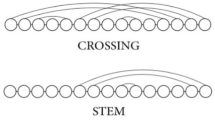Abstract
In molecular biology, RNA structure comparison and motif search are of great interest for solving major problems such as phylogeny reconstruction, prediction of molecule folding and identification of common functions. RNA structures can be represented by arc-annotated sequences (primary sequence along with arc annotations), and this paper mainly focuses on the so-called arc-preserving subsequence (APS) problem where, given two arc-annotated sequences (S,P) and (T,Q), we are asking whether (T, Q) can be obtained from (S, P) by deleting some of its bases (together with their incident arcs, if any). In previous studies, this problem has been naturally divided into subproblems reflecting the intrinsic complexity of the arc structures. We show that APS(Crossing, Plain) is NP-complete, thereby answering an open problem posed in . Furthermore, to get more insight into where the actual border between the polynomial and the NP-complete cases lies, we refine the classical subproblems of the APS problem in much the same way as in and prove that both APS \((\{\sqsubset, \between\}, \emptyset)\) and APS \((\{<, \between\}, \emptyset)\) are NP-complete. We end this paper by giving some new positive results, namely showing that APS \((\{\between\}, \emptyset)\) and APS( \((\{\between\}, \{\between\})\) are polynomial time.
This work was partially supported by the French-Italian PAI Galileo project number 08484VH and by the CNRS project ACI Masse de Données ”NavGraphe”. A preliminary version of this paper appeared in the Proc. of IWBRA’05, Springer, V.S. Sunderam et al. (Eds.): ICCS 2005, LNCS 3515, pp. 860-868, 2005.
Access this chapter
Tax calculation will be finalised at checkout
Purchases are for personal use only
Preview
Unable to display preview. Download preview PDF.
Similar content being viewed by others
References
Alber, J., Gramm, J., Guo, J., Niedermeier, R.: Towards optimally solving the longest common subsequence problem for sequences with nested arc annotations in linear time. In: Apostolico, A., Takeda, M. (eds.) CPM 2002. LNCS, vol. 2373, pp. 99–114. Springer, Heidelberg (2002)
Alber, J., Gramm, J., Guo, J., Niedermeier, R.: Computing the similarity of two sequences with nested arc annotations. Theoretical Computer Science 312(2-3), 337–358 (2004)
Billoud, B., Guerrucci, M.-A., Masselot, M., Deutsch, J.S.: Cirripede phylogeny using a novel approach: Molecular morphometrics. Molecular Biology and Evolution 19, 138–148 (2000)
Caetano-Anolls, G.: Tracing the evolution of RNA structure in ribosomes. Nucl. Acids. Res. 30, 2575–2587 (2002)
Chaia, W., Stewart, V.: RNA Sequence Requirements for NasR-mediated, Nitrate-responsive Transcription Antitermination of the Klebsiella oxytoca M5al nasF Operon Leader. Journal of Molecular Biology 292, 203–216 (1999)
Evans, P.: Algorithms and Complexity for Annotated Sequence Analysis. PhD thesis, U. Victoria (1999)
Evans, P.: Finding common subsequences with arcs and pseudoknots. In: Crochemore, M., Paterson, M. (eds.) CPM 1999. LNCS, vol. 1645, pp. 270–280. Springer, Heidelberg (1999)
Farris, A.D., Koelsch, G., Pruijn, G.J., van Venrooij, W.J., Harley, J.B.: Conserved features of Y RNAs revealed by automated phylogenetic secondary structure analysis. Nucl. Acids. Res. 27, 1070–1078 (1999)
Garey, M., Johnson, D.: Computers and Intractability: A Guide to the Theory of NP-Completeness. W. H. Freeman and Company, New York (1979)
Goldman, D., Istrail, S., Papadimitriou, C.H.: Algorithmic aspects of protein structure similarity. In: Proc. of the 40th Symposium of Foundations of Computer Science (FOCS 1999), pp. 512–522 (1999)
Gramm, J., Guo, J., Niedermeier, R.: Pattern matching for arc-annotated sequences. In: Agrawal, M., Seth, A.K. (eds.) FSTTCS 2002. LNCS, vol. 2556, pp. 182–193. Springer, Heidelberg (2002)
Guo, J.: Exact algorithms for the longest common subsequence problem for arc-annotated sequences. Master’s Thesis, Universitat Tubingen, Fed. Rep. of Germany (2002)
Hellendoorn, K., Michiels, P.J., Buitenhuis, R., Pleij, C.W.: Protonatable hairpins are conserved in the 5’-untranslated region of tymovirus RNAs. Nucl. Acids. Res. 24, 4910–4917 (1996)
Hofacker, L., Fekete, M., Flamm, C., Huynen, M.A., Rauscher, S., Stolorz, P.E., Stadler, P.F.: Automatic detection of conserved RNA structure elements in complete RNA virus genomes. Nucl. Acids. Res. 26, 3825–3836 (1998)
Jiang, T., Lin, G.-H., Ma, B., Zhang, K.: The longest common subsequence problem for arc-annotated sequences. In: Giancarlo, R., Sankoff, D. (eds.) CPM 2000. LNCS, vol. 1848, pp. 154–165. Springer, Heidelberg (2000)
Juan, V., Crain, C., Wilson, S.: Evidence for evolutionarily conserved secondary structure in the H19 tumor suppressor RNA. Nucl. Acids. Res. 28, 1221–1227 (2000)
Lancia, G., Carr, R., Walenz, B., Istrail, S.: 101 optimal PDB structure alignments: a branch-and-cut algorithm for the maximum contact map overlap problem. In: Proceedings of the 5th ACM International Conference on Computational Molecular Biology (RECOMB 2001), pp. 193–202 (2001)
Teunissen, S.W.M., Kruithof, M.J.M., Farris, A.D., Harley, J.B., van Venrooij, W.J., Pruijn, G.J.M.: Conserved features of Y RNAs: a comparison of experimentally derived secondary structures. Nucl. Acids. Res. 28, 610–619 (2000)
Vialette, S.: Pattern matching over 2-intervals sets. In: Apostolico, A., Takeda, M. (eds.) CPM 2002. LNCS, vol. 2373, pp. 53–63. Springer, Heidelberg (2002)
Vialette, S.: On the computational complexity of 2-interval pattern matching. Theoretical Computer Science 312(2-3), 223–249 (2004)
Wang, H.-Y., Lee, S.-C.: Secondary structure of mitochondrial 12S rRNA among fish and its phylogenetic applications. Molecular Biology and Evolution 19, 138–148 (2002)
Wuyts, J., De Rijk, P., Van de Peer, Y., Pison, G., Rousseeuw, P., De Wachter, R.: Comparative analysis of more than 3000 sequences reveals the existence of two pseudoknots in area V4 of eukaryotic small subunit ribosomal RNA. Nucl. Acids. Res. 28, 4698–4708 (2000)
Zhang, K., Wang, L., Ma, B.: Computing the similarity between RNA structures. In: Crochemore, M., Paterson, M. (eds.) CPM 1999. LNCS, vol. 1645, pp. 281–293. Springer, Heidelberg (1999)
Zuker, M.: RNA folding. Meth. Enzymology 180, 262–288 (1989)
Author information
Authors and Affiliations
Editor information
Editors and Affiliations
Rights and permissions
Copyright information
© 2005 Springer-Verlag Berlin Heidelberg
About this paper
Cite this paper
Blin, G., Fertin, G., Rizzi, R., Vialette, S. (2005). What Makes the Arc-Preserving Subsequence Problem Hard?. In: Priami, C., Zelikovsky, A. (eds) Transactions on Computational Systems Biology II. Lecture Notes in Computer Science(), vol 3680. Springer, Berlin, Heidelberg. https://doi.org/10.1007/11567752_1
Download citation
DOI: https://doi.org/10.1007/11567752_1
Publisher Name: Springer, Berlin, Heidelberg
Print ISBN: 978-3-540-29401-6
Online ISBN: 978-3-540-31661-9
eBook Packages: Computer ScienceComputer Science (R0)




